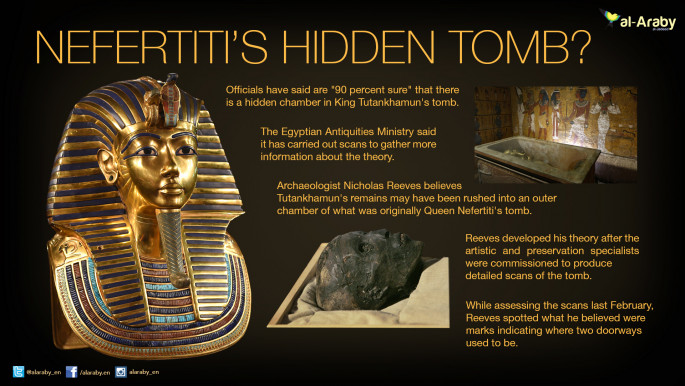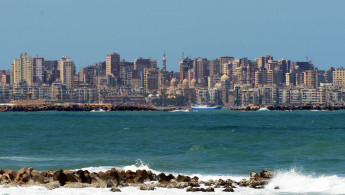Revealing the hidden world buried beneath Alexandria's waters
Society: Egypt might soon finally kick-off ambitious plans for an underwater museum, which could reveal the secrets of ancient Alexandria's past to the world.
3 min read
Alexandria could become home to the world's first underwater museum [AFP]
Buried beneath the rolling waves of the Mediterranean Sea lies one of Egypt's most valuable but little known historical sites.
For 1,400 years, statues of Cleopatra, Ptomely and other greats from ancient Egypt have remained dormant, unseen and often unknown to the people on the land.
Alexandria is already rich in cultural heritage and reminders of the past, but a new project aims to recover the forgotten memorials to ancient Egypt's gods, queens and thinkers.
An underwater museum has been mooted for the past 20 years but might finally be getting the funding it needs to showcase Alexandria's submerged district.
It is not just statues that would be revealed, but towering columns, palaces and huge stone blocks, which all made ancient Alexandria probably the most important city in the world at its time.
One block is believed to be the foundations of the mythical 450 foot high Pharos lighthouse, The Smithsonian magazine reported, one of the seven ancient wonders of the world.
It would be the first museum of its kind and a way of boosting Egypt's flailing tourism industry after years of unrest.
"In five metres of water, we have these remains of palaces and temples, but nothing people can see with their own eyes," Mohammed Abd el-Maguid, head of underwater activities at the Ministry of Antiquities, told the magazine.
"Having a museum like this will attract more tourists that will help the economy move again."
What will might get the idea of the underwater museum moving again, the magazine reported, is Chinese cash.
This will help French architect Jacques Rougerie realise a decades' long dream to see the underwater city come to life.
Tourists and Egyptians would walk through huge fibreglass tunnels to get a glimpse of the subaquatic city, 20 metres below the surface.
There are other fantastical designs for the project, including an academic archaeology school.
It would help people get a better understanding of how Alexandrians once lived, with regular fixtures of everyday life revealed - from dominating lecture halls to simple homes.
"The public could assist the work of the archaeologists on archaeological treasures like Cleopatra's palace or the royal court that have been hidden from the public for thousands of years," Rougerie told The Smithsonian.
Although the original idea was to have the items displayed in museums on land, Maguid became captivated by the idea of an extraordinary underwater attraction.
"Fixed remains, like the pediments of the large buildings, can't be taken out," Maguid told the magazine.
"We also have more than two million objects in Egypt, all above ground. If we were to take these out of the water, what would be the difference? Here we have something new."
For 1,400 years, statues of Cleopatra, Ptomely and other greats from ancient Egypt have remained dormant, unseen and often unknown to the people on the land.
Alexandria is already rich in cultural heritage and reminders of the past, but a new project aims to recover the forgotten memorials to ancient Egypt's gods, queens and thinkers.
An underwater museum has been mooted for the past 20 years but might finally be getting the funding it needs to showcase Alexandria's submerged district.
It is not just statues that would be revealed, but towering columns, palaces and huge stone blocks, which all made ancient Alexandria probably the most important city in the world at its time.
One block is believed to be the foundations of the mythical 450 foot high Pharos lighthouse, The Smithsonian magazine reported, one of the seven ancient wonders of the world.
It would be the first museum of its kind and a way of boosting Egypt's flailing tourism industry after years of unrest.
"In five metres of water, we have these remains of palaces and temples, but nothing people can see with their own eyes," Mohammed Abd el-Maguid, head of underwater activities at the Ministry of Antiquities, told the magazine.
"Having a museum like this will attract more tourists that will help the economy move again."
What will might get the idea of the underwater museum moving again, the magazine reported, is Chinese cash.
This will help French architect Jacques Rougerie realise a decades' long dream to see the underwater city come to life.
Tourists and Egyptians would walk through huge fibreglass tunnels to get a glimpse of the subaquatic city, 20 metres below the surface.
 |
The public could assist the work of the archaeologists on archaeological treasures like Cleopatra's palace or the royal court - Jacques Rougerie, French architect |
 |
There are other fantastical designs for the project, including an academic archaeology school.
It would help people get a better understanding of how Alexandrians once lived, with regular fixtures of everyday life revealed - from dominating lecture halls to simple homes.
"The public could assist the work of the archaeologists on archaeological treasures like Cleopatra's palace or the royal court that have been hidden from the public for thousands of years," Rougerie told The Smithsonian.
Although the original idea was to have the items displayed in museums on land, Maguid became captivated by the idea of an extraordinary underwater attraction.
"Fixed remains, like the pediments of the large buildings, can't be taken out," Maguid told the magazine.
"We also have more than two million objects in Egypt, all above ground. If we were to take these out of the water, what would be the difference? Here we have something new."
 |





 Follow the Middle East's top stories in English at The New Arab on Google News
Follow the Middle East's top stories in English at The New Arab on Google News


